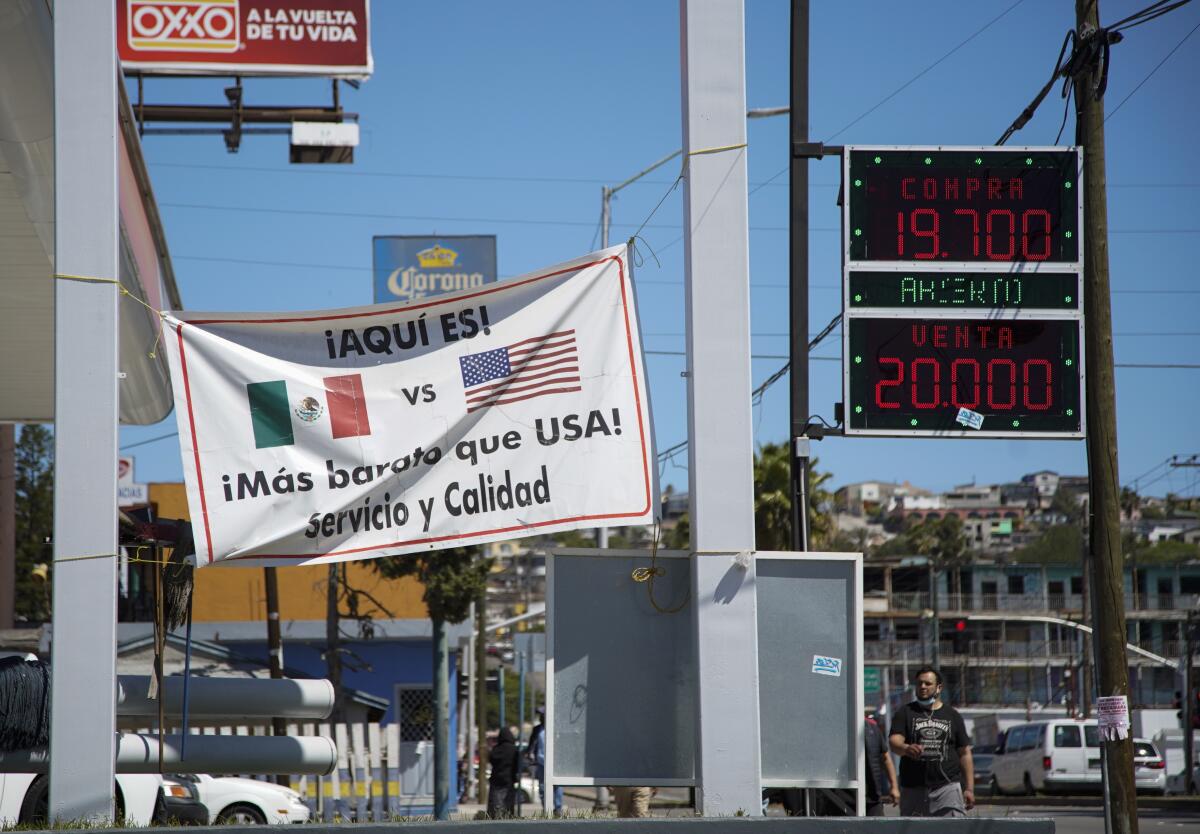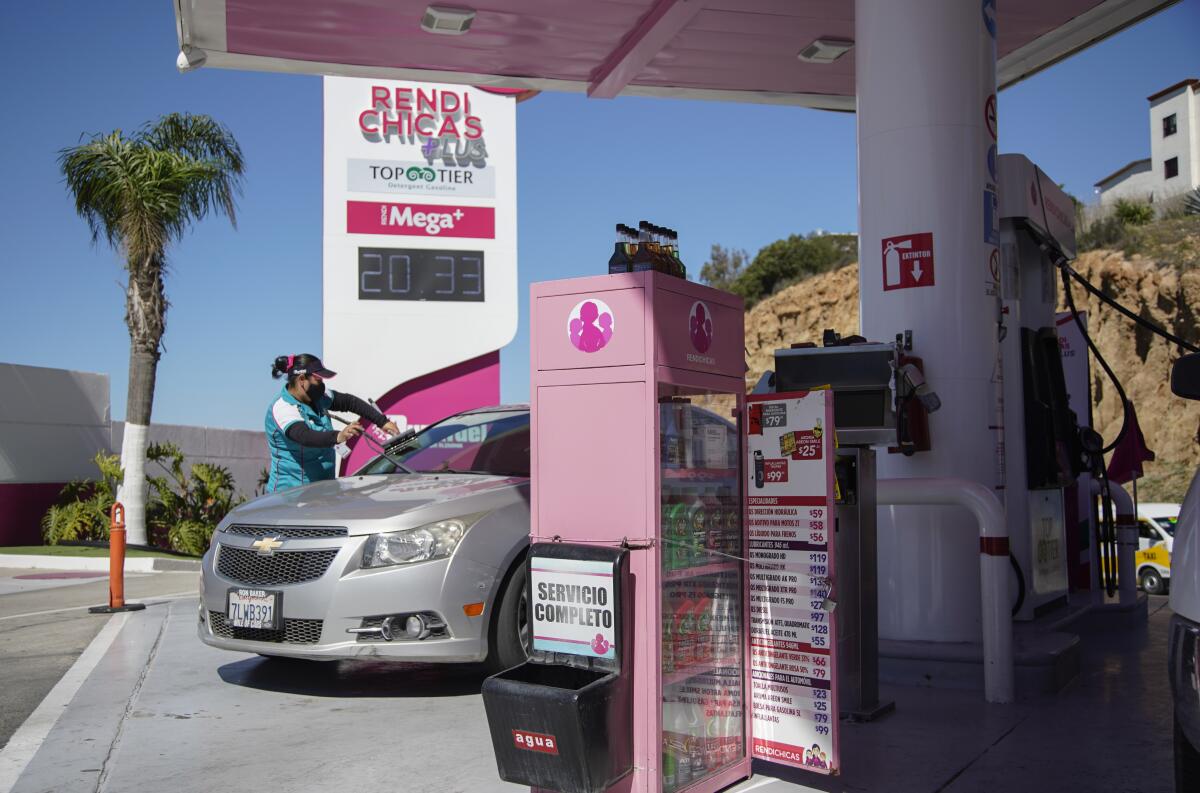Californians find bargain gas prices in Mexico

California residents facing high gas prices drive to Mexico to fill their tanks.
- Share via
TIJUANA — Claudia Jessica Villarreal used to fill up her gray Nissan Pathfinder near her home in Chula Vista, Calif. Then Russia invaded Ukraine and gasoline prices went bonkers.
The 54-year-old psychologist soon discovered a bargain.
A dozen miles south, just across the U.S.-Mexico border in Tijuana, regular gas sells for an average of $3.96 a gallon — nearly $2 less than in California.
She was in Tijuana on Wednesday to take her children to a doctor’s appointment, so it wasn’t a big deal to swing by the Santa Fe gas station on Salinas Boulevard to fill up. But she’s also been making special trips.
“I swear, I’ve been coming once a week,” she said. “I cross when I can.”
She can thank one man for the discount: Mexican President Andrés Manuel López Obrador.

As the war in Ukraine triggered a run-up in world oil prices, his administration vowed to keep prices under control by providing subsidies to Mexican oil companies and refineries.
“The state should not neglect its social responsibility, and the state is here to protect people,” the populist president, who faces a recall election next month, said at a recent news conference. “It’s not about leaving everything up to the market.”
Now banners at Mexican gas stations in Tijuana flaunt their prices with signs like “Cheaper than in the U.S.A.!”
Although the lower prices have enticed Californians who live near the border and are willing to sit in traffic to get back and forth, the real beneficiaries have been Mexicans.
Mexico is a major oil producer, but with a shortage of refineries to turn it into fuel, it imports 80% of its gasoline from the United States.
Mexican consumers wind up footing the bill for the transportation costs to bring it over, said John Padilla, a managing director at the energy consulting firm IPD Latin America.
Before the war, prices at the pump were normally higher than those in the United States. It wasn’t uncommon for Mexicans who live near the border to drive north to fill their tanks.
In 2017, after deregulation of the oil industry drove up gasoline prices and ignited violent protests, stations in Calexico, Calif., saw especially brisk business. Some Mexican customers filled up containers to bring back with them.
Now that the situation is reversed, López Obrador has been basking in the moment. “We’re not going to close the border,” he joked at his news conference.
His subsidies have resonated with supporters like 62-year-old María de los Angeles Resendiz, who lives in the state of Mexico and sells cosmetics.

“He’s looking after Mexicans,” she said. “He’s looking after all of Mexico.”
Alejandro Montufar, head of the PetroIntelligence consulting group in Mexico City, said the subsidies made sense as a strategy to help avoid social unrest and combat inflation.
But critics say the subsidies are unsustainable, even as officials promise that Mexico will cover the cost with the extra money it earns from its oil exports in the current market.
“There are better places to spend or invest” the money that the government is losing by trying to keep prices down, said Luis Cházaro, a federal congressman from the Party of the Democratic Revolution.
“When this ends, people are still going to be expecting the subsidy,” he said. “I don’t think it’s viable to maintain.”
Duncan Wood, a Mexico expert at the Wilson Center think tank in Washington, said the subsidies have a “perverse logic” because they’ll benefit the middle class more than poor people, who often don’t have cars.
Mexico is not the only country that has adopted subsidies in the last few weeks.
El Salvadoran President Nayib Bukele said Monday that his country had temporarily suspended several fuel taxes and was looking to do more “to keep our prices reduced.”
In California, Gov. Gavin Newsom on Wednesday released details of a proposal to pay vehicle owners $400 for each car or truck they have registered in the state. The plan, which would cost $11 billion, also includes grants to offer free or reduced public transit.
“This is a pretty standard thing to do,” said David Victor, an energy policy expert at UC San Diego. “When politicians feel weak in power, a highly visible way for them to do things that are favorable to voters is to control the things that voters pay a lot of attention to and gasoline prices are always at the top of the list.”
In many countries, the surge in gasoline prices, which had already been rising for months, “was politically intolerable,” he said.
López Obrador has staked much of his presidency on the oil industry, which became a source of pride after the government nationalized it in 1938. His predecessor, Enrique Peña Nieto, implemented a sweeping energy overhaul that opened up the sector to private and foreign investment to revive the industry after years of declining oil production.
López Obrador has focused on rolling back those changes and strengthening state control over the energy sector, halting renewable energy projects and seeking to increase Mexico’s refining capacity and reduce crude oil exports to achieve energy independence.
He’s used his energy overhaul to rally voters before the April 10 recall election. With a current approval rating of about 60%, López Obrador backed the recall election in hopes of showcasing his support and is expected to triumph.
Back in Tijuana, Patricia Saharagui, a spokesperson for the Rendichicas gas station chain, estimated that its locations near the border have seen a 6% increase in sales in the month since the war began. She welcomed Californians.
“It’s an opportunity for them to come and try,” she said. “It also shows them how in Mexico we also have good-quality gasoline.”
The chain has begun a digital campaign to promote its lower prices. “Don’t worry be happy in Tijuana,” one advertisement says in pink block letters.
At one Rendichicas station, about half the cars that pulled in had California license plates. Unlike California stations, where people pump their own gas, Mexican ones are full-service.
One attendant, Lupita Rivas, said she can spot Americans without even looking at their plates because they pay in dollars and ask the price per gallon instead of per liter.
“The lines don’t end,” she said Wednesday morning.
One customer was 48-year-old Mónica López, who drove down from Chula Vista and filled up at pump No. 1.
“I worry a lot” about gas prices, she said. “The drastic rise in the price of gas affects all of us.”
The station also benefits from sales to locals who used to fill their tanks in the United States, including Doyma Torres, a 61-year-old Uber driver.
“Horrible. It’s very bad, very high.... That’s why we’re filling up here,” she said. “If it stays this way, excellent, it’s convenient for us.”
Now that she fills up on the Mexican side of the border, she does far fewer Uber trips in the United States.
Alejandro Borja Robles, president of a group representing the gasoline sector in Tijuana’s chamber of commerce, said he was grateful for the boost in business.
But he also expressed misgivings that it came as a result of the war in Ukraine: “I don’t enjoy the fact that we’re selling more gasoline because people are suffering.”
More to Read
Sign up for Essential California
The most important California stories and recommendations in your inbox every morning.
You may occasionally receive promotional content from the Los Angeles Times.












